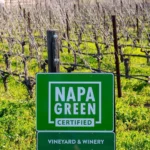First Day of Napa RISE Climate and Wine Symposium Emphasizes Importance of Water Monitoring, Irrigation Management
-
 Katherine Martine | Wine Business monthly
Katherine Martine | Wine Business monthly
- |
Shares How Advanced Technologies Can Play a Role in Water Efficiency and Savings
The important role of water management and metering in maximizing water use efficiency for more sustainable farming and a healthier water table and environment was a key takeaway from the first day of Napa Green’s third Napa RISE Climate & Wine Symposium at Charles Krug Winery in St. Helena.
The conference—which runs April 29 – May 1 and May 6 – 8—kicked off Tuesday with a day of keynotes and workshops, each with their own action items for attendees to implement at home, focused on water savings and efficiency.
One of the first panels of the morning took place outside near the vineyard where BCG Water consulting discussed navigating water regulations and compliance. Representatives from Meter.Me and Lumo conducted a show and tell of their respective water management tech.
Ashley Boudet, the president and founder of BCG Water who’s been helping wineries with water regulation compliance for the last decade, shared why water data matters so much in this day in age. She asked the audience how many people track daily water use by the gallon; a handful of people raised their hands.
“We can do better,” she said. “Why (does) water data matter so much? Napa has faced historic droughts and extreme rainfall… water is really not just a statistic anymore, we really need to start focusing on it. The true challenge isn’t how much water we use, it’s how well we understand it.”
Boudet said water monitoring tools can help us track whether there’s a leak, or a section of a plot that’s being overwatered, water pressure issues, etc. Essentially, they can help find water inefficiencies, helping you mitigate those by taking action. As an example, she recalled a client who installed 20 water meters per facility, and after 12 months they analyzed the data and realized that they were using four million gallons of water just for landscape irrigation.
“So, you know, that opens some eyes to really start looking at those things a little closer: Do we need those kinds of plants? Then do those plants really need that much water? Is the water hitting the plants, or is it running off into a drainage system, what’s going on?”
That’s where companies like Lumo and Meter.Me come into play.
Ofer Tenenbaum, co-founder, product roadmap at Meter.Me, shared information about their cloud-based water management system. The system uses long-range lot networks that don’t rely on cellular data or Wi-Fi networks and it can run on solar or wind power. With this technology, you can monitor tanks, wells, water meters and ponds from your smart device. Castello di Amorosa winery is a Meter.Me user. Georg Salzner, president at Castello, noted that the system can provide other alerts as well. In addition to getting notified about and catching leaks, he’ll also receive a notification if the winery generators start running.
From a wildfire standpoint, Tenenbaum added that Meter.Me data and information from water tanks can be shared with local firefighters right to their command tablets on their fire trucks, showing them how many gallons of water is available and where and the type of valve they can use to draw from that tank if necessary.
Devon Wright is the co-founder and CEO of Lumo, the company behind the Lumo smart valve that is equipped with a built in flow meter and an onboard computer allowing for 24/7 remote control and access. WineBusiness reported on the Lumo technology in 2023 when it was first being used at BV. The valve can be controlled anywhere from a smartphone or computer to control, monitor and measure irrigation. With this you can more easily report on water use, irrigate based on precise levels and irrigate at night. Antinori Napa Valley uses Lumo and Senior Vineyard Manager, Andrew Oliver, expressed that its use can even help better inform vineyard supplies orders.
Suggested attendee action items from this talk included:
- Install and leverage water metering
- Implement regular monitoring protocols
- Set specific water reduction targets
- Develop leak detection procedures
- Optimize the timing & amount of irrigation for water efficiency & grape quality
Following the workshops–another one was held inside discussing Dominus Estate and Pine Ridge Vineyards’ transition to dry farming. Pine Ridge was also the recipient of the Napa RISE Leadership Award for water efficiency and savings.
Noted journalist and author Mark Arax—who’s been writing about California wildfires for the last two decades, including penning several recent guest essays in the New York Times—delivered the keynote address.
Reading an excerpt from his book, “The Dreamt Land: Chasing Water and Dust Across California,” Arax shared how while growing up in the Central Valley where his father farmed raisins, he didn’t initially stop to ponder how much we plunder, whether that’s water, soil or minerals like gold during the California Gold Rush, or even plundering the land moving into and sprawling housing and urban developments into the Wildland Urban Interface.
Through reporting, history and self reflection, Arax’s book explores the battles over water in California with farming and considers the state’s water distribution system, built in the 40’s, 50’s and 60’s. It’s a system struggling to keep up with the state’s growth and farming and Arax asks ‘what magnitude can this go to’? In some places, he pointed out, the state’s aquifer has sunk by a matter of feet.
While California’s Sustainable Groundwater Management Act is meant to address these issues and better manage groundwater, he noted the issue of enforcement and farmer pushback; for instance in the Central Valley he said climate change are two words that farmers don’t like to utter.
Arax said we’ve entered into what he believes is the last extraction—as a state we’re trying to decide where to go in terms of farmland and suburbia as it continues encroaching into the wildland urban interface.
It’s a reminder of the importance of our resources, including water as a resource and the decisions we make around irrigation. As Napa Green’s Executive Director Anna Brittain put it, “I just want to talk a little bit about water and how interconnected it is to so many elements of our lives.”
“It’s probably the resource most impacted by climate change… It’s deeply connected with energy. It’s deeply connected to soil health and forest health, and the ability to infiltrate and store and retain water, but also we are all at least 60% water—depending on how much wine we drink.”
Action opportunities for attendees from the keynote included:
- Understand the forces shaping current water policies
- Identify patterns of water management success and failure
- Prepare for the Groundwater Sustainability Plan and how it will influence water management
- Evaluate vineyard management strategies to build resilience to cycles of drought, heat stress, and rapid & intense rain events
- Think big picture about how forests and grasslands are impacting groundwater storage and availability


